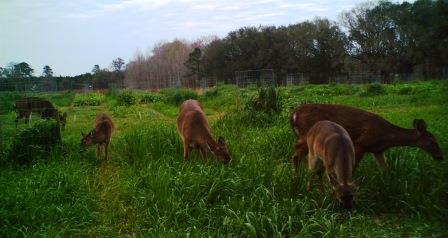
by Mark Mauldin | Dec 5, 2014

Deer grazing test plots at the NFREC in Quincy. Quality food plots take effort and planning.
Deer hunting season has begun in Northwest Florida. As hunters venture into the woods and sit for hours on end they have plenty – sometimes too much – time to contemplate what they could have done or should do to make there hunting experiences better. These plans for improvement may involve all kinds of things; if they involve improving underperforming food plots allow me to offer a few points for contemplation.
- Are your plots the optimum size? Small plots, less than one acre, don’t stand much of a chance. If you plant something deer like and there is a substantial deer population in the area the young plants will be “mowed” down before they have time to establish. At best, you’ll create a low growing green carpet. This might make you feel better as a hunter but it’s doing very little in the way of providing nutrition to the deer herd. Deer will get the maximum benefit from multiple plots (2-3 acres in size) that total around 10% of the area you are managing. This scenario is ideal for the deer, it might not be ideal or even feasible for the hunter.
- Are your plots properly fertilized? This is a very common issue with underperforming food plots. That bag of 10-10-10 really doesn’t do much. Hunters who have no farming experience are often amazed and disheartened at how much fertilizer it takes to produce a crop – food plots are simply forage crops. Consult your county’s agriculture agent for assistance with soil testing and fertilizer recommendations for the specific crops you are producing. UF/IFAS fertilizer recommendations for forage crops reference additional applications after a grazing rotation or haying; how does this translate for food plot management? A cool season food plot planted in mid-October will be productive for about six months. During that six months you should apply Nitrogen at least three times, Potassium twice, all required Phosphorus can be applied at planting. This steady supply of nutrients keeps the food plot going throughout the entire growing season. Using slow release or enhanced efficiency fertilizers can simplify this process somewhat, since the number of applications is reduced.
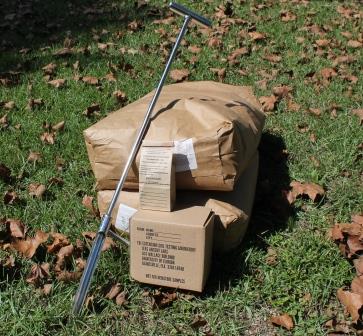
Soil testing and the resulting fertilizer recommendations are key to successful food plots.
- Did you plant the right crop at the right time? There are lots of choices when it comes to selecting what to plant in your food plots remember plant varieties that are suited to your particular environment not the one that have the prettiest packaging or the most TV commercials. Planting time can be an issue; when cool season crops are planted too late they are unable to establish enough roots and top growth to withstand grazing pressure through the middle of winter when short days and cold temperatures greatly slow growth rates. Even if planted at the correct time most “winter” forages produce the majority of their biomass in the spring, once day length begins to increase.
Hopefully considering these points will help you to improve your food plots. Remember, producing high quality food plots can be a challenging endeavor but the process makes more sense and is less frustrating if you view food plots as long term habitat improvement designed to provide additional nutrition to the deer herd not simply an attractant during hunting season. For more information on any of the topics addressed contact your county’s UF/IFAS Extension Agriculture or Natural Resources Agent.
by Mark Mauldin | Jun 6, 2014
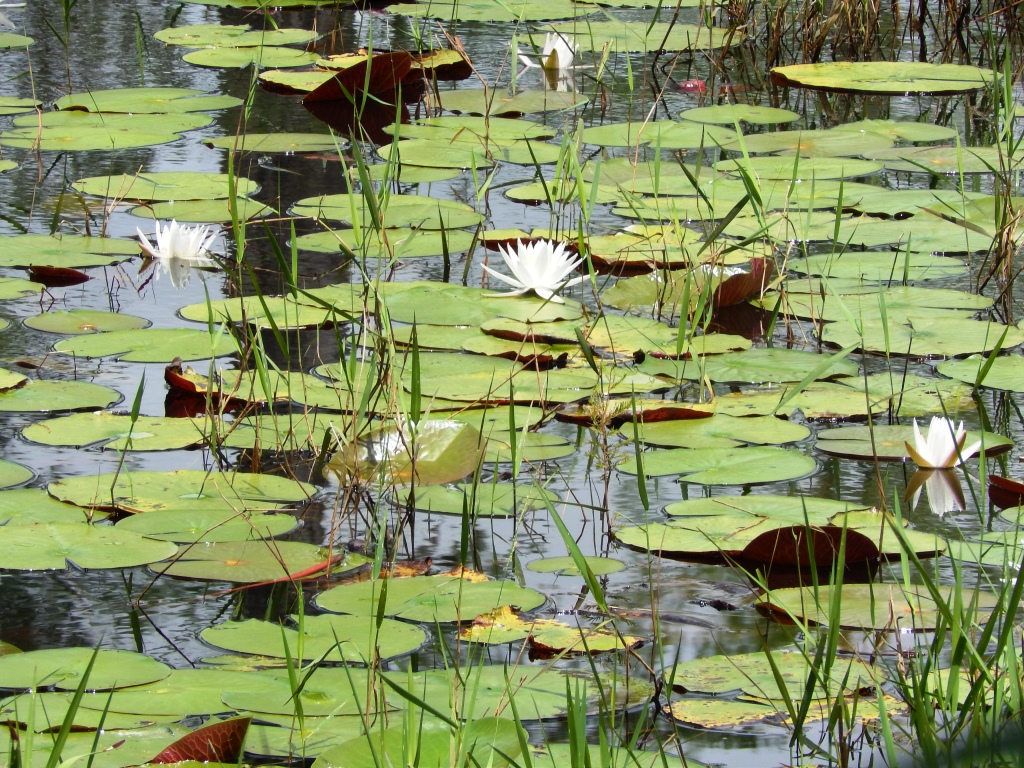
Excess aquatic weeds can be a source of frustration for pond owners.
Privately owned ponds and lakes are common across the Panhandle. Ponds can be a source of great enjoyment and frustration for their owners. When all is well a pond is a welcome addition to most any landscape. However, when problems arise pond owners are often times at a loss for how to rectify the situation. Unwanted or excess weeds in a pond is a one of the most common frustrations for pond owners. Luckily, aquatic weed control, an otherwise daunting task, can be manageable if some basic principles are understood.
UF/IFAS extension faculty from Calhoun, Holmes, Jackson, and Washington counties will be presenting a workshop on Thursday, June 12th to help educate pond owners regarding some of the principles of effectively controlling unwanted weeds in their ponds. Topics covered will include pond weed identification, weed control options, aquatic herbicide selection and application, and the use of grass carp for weed control.
The workshop will be held in Chipley at the Washington County Agricultural Center, starting at 6:30 the evening of the 12th. There is a $5 registration fee for this event. Space is limited so early registration is highly encouraged. To register call the Washington County Extension Office at (850)638-6180 or email Mark Mauldin mdm83@ufl.edu
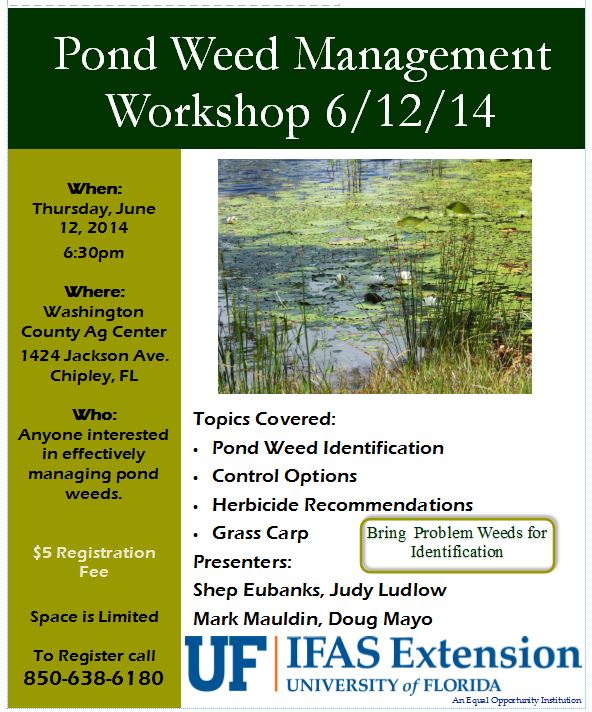
by Mark Mauldin | Mar 21, 2014

Deer grazing test plots at the NFREC in Quincy. Food plots can benefit deer year round, not just during hunting season.
To the chagrin of hunters across the panhandle deer season has drawn to a close. As the days lengthen and temperatures begin to climb, many of the area’s outdoorsmen (and women) shift their focus to a more aquatic nature. However, those sportsmen, who will place a premium on antler size in the fall, should not neglect the nutritional needs of the deer herd during the spring and summer months.
There is a well-documented correlation between deer nutrition and antler growth. Antler growth is suppressed when adequate nutrition is not available. Antler growth requires a large amount of energy and protein. The energy requirements for antler growth can generally be met by the deer’s natural environment. However, some natural environments may not supply enough protein to maximize antler growth. Nutrition is only one of several factors effecting antler growth but it is perhaps the easiest of those factors to alter.
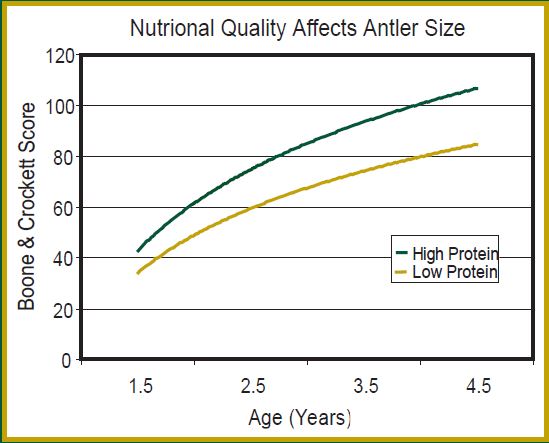
Source: Mississippi State University, Forest & Wildlife Research Center
http://www.fwrc.msstate.edu/pubs/antler.pdf
As with all animals, a deer’s nutritional demands change over time. The suppressing effect of insufficient protein in the diet is most evident in younger bucks. This is because the bodies of immature deer are still growing. The processes of growth and development demand protein. When antler growth is added to the equation the protein demand of a young buck can easily exceed what is provided by it natural environment. Research indicates that young, growing deer during antler development need a diet that is approximately 16% crude protein in order to maximize antler growth. Mature bucks can maximize antler growth with as little as 10% crude protein.
Planting and maintaining warm season food plots is a good way for a deer herd manager to help prevent any nutritional limitations to antler growth. Food plots are often thought of in terms of their ability to attract deer to a specific location during hunting season. However, if properly utilized food plots can have a lasting positive effect on an area’s deer herd and other wildlife. Follow the links for the basics on food plot establishment and soil fertility management.
If your goal is to increase the amount of protein available to the deer herd then legumes are your best bet. Some warm season legumes that do well in the panhandle include Aeschynomene, Alyceclover, Cowpeas, Soybeans, Lablab, and Perennial Peanut. It is important that you select species and varieties that are suited to the conditions (especially soil properties) of the area you intend to use them. It is also recommended that you plant a variety of species in any food plot.

The species listed vary in terms of grazing tolerance and recommended planting technique. Contact your county’s extension office for more details.
Legumes provide high amounts of protein to deer and other wildlife because they contain relatively high amounts of nitrogen. Due to a symbiotic relationship with a specific type bacteria, legumes are able to utilize atmospheric nitrogen. Other plants are dependent solely on soil nitrogen. To ensure that the proper bacteria is available to the legume it is important to inoculate legume seeds prior to planting. Inoculants are available through most seed dealers. Be sure that you get the proper inoculant for the species you are planting. Aeschynomene, Alyceclover, and Cowpeas all require the inoculant for the cowpea group. Soybeans and Lablab each have a species specific inoculant. Perennial Peanut does not require inoculation because it is not planted from seeds. Additional information about inoculants, planting techniques, and fertilization is available from your county’s extension office.
Planting food plots does not guarantee any additional antler growth but it is one way to help alleviate a possible limiting factor. Habitat improvement and additional available nutrition can benefit the entire ecosystem. If you want to get the most out of your property, in terms of deer production, it is important to provide the deer what they need all year long, not just during hunting season.
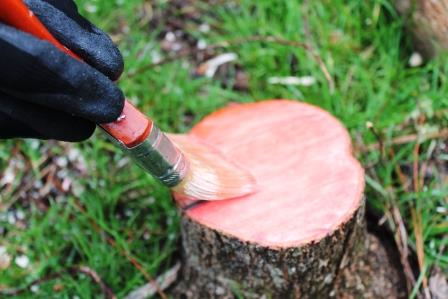
by Mark Mauldin | Feb 20, 2014
As Floridians we often struggle to find any upside to these cold, gray days we’ve been experiencing past few months. As “unfloridian” as our winters can be they pale in comparison to those endured by the more northern states. In fact, the last days of winter can be the ideal time of year in the Panhandle to tackle some outdoor chores like controlling unwanted trees and other woody plants.
Controlling trees can be hard work, the cooler temperatures can make the task a little less taxing. The relative inactivity of the “creepy crawlies” and pests often found in wooded areas is another reason to consider completing tree and woody plant removal projects during the winter.
Tree control generally involves mechanical removal. In some cases mechanical removal provides only short term control; in other cases it can actually increase the number of unwanted plants over time. This is the problem with both Chinese tallow (popcorn tree) and privet. Herbicide treatments can eliminate the possibility of regrowth and provide permanent control. The herbicide application techniques used to control trees and other woody plants are very selective and they are effective during the winter. These techniques provide opportunities to use herbicides in a controlled and very targeted manner with very little risk to surrounding plants. Additionally, the techniques below are most effective through the fall and winter when sap flow in trees is lessened.
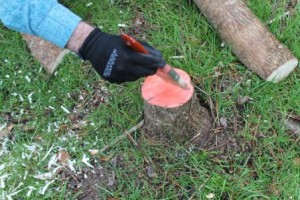
For best results the cut stump treatment should be done immediately after the tree has been cut down. Photo courtesy of Mark Mauldin.
The cut stump technique is a fairly common and very effective method of achieving permanent control of woody plants. As the name implies, the first step in the cut stump technique is to cut down the tree. Immediately after cutting down the tree spray or paint the stump with herbicide. On smaller stumps the entire surface should be covered with herbicide; on larger stumps effective control can be achieved by only covering the outside three inches of the stump.
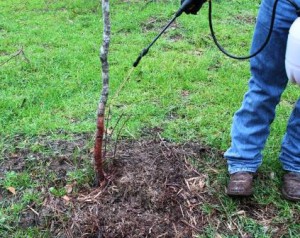
With the basal treatment, cover the bottom 12 to 18 inches of the tree with the herbicide oil mixture. Be sure to cover the entire circumference of the tree. Photo courtesy of Mark Mauldin.
Two additional herbicide application techniques that work well on woody plants do not require the plants to be cut down first. The basal application technique works best on smooth barked woody plants with a diameter of less than six inches. This technique involves spraying the bottom 12 to 18 inches of the tree with an herbicide oil mixture.
The hack and squirt method works well on large and/or thick barked trees. This technique involves using hatchet or other tool to cut through the bark around the circumference of the tree, then applying herbicide directly to the cut. Several months should pass between herbicide application using either of these techniques and mechanical removal.
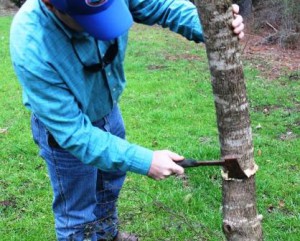
The hack and squirt treatment is best for large and/or thick barked trees. Photo courtesy of Mark Mauldin.
Be sure to read and follow the label of any herbicide you use. Always wear the proper personal protective equipment. For more information on the techniques described, including recommended herbicides and rates, read Herbicide Application Techniques for Woody Plant Control or contact your county’s UF/IFAS Extension Office.











